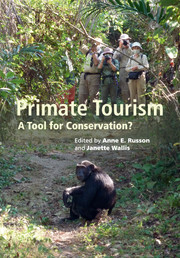Book contents
- Frontmatter
- Contents
- List of contributors
- Part I Introduction
- Part II Asian primates
- 2 Tourism, infant mortality, and stress indicators among Tibetan macaques at Huangshan, China
- 3 Provisioning and tourism in free-ranging Japanese macaques
- 4 Proboscis monkey tourism
- 5 Orangutan tourism and conservation
- 6 The impact of tourism on the behavior of rehabilitated orangutans (Pongo abelii) in Bukit Lawang, North Sumatra, Indonesia
- Part III African primates
- Part IV Neotropical primates
- Part V Broader issues
- Part VI Conclusion
- Index
- References
6 - The impact of tourism on the behavior of rehabilitated orangutans (Pongo abelii) in Bukit Lawang, North Sumatra, Indonesia
from Part II - Asian primates
Published online by Cambridge University Press: 05 September 2014
- Frontmatter
- Contents
- List of contributors
- Part I Introduction
- Part II Asian primates
- 2 Tourism, infant mortality, and stress indicators among Tibetan macaques at Huangshan, China
- 3 Provisioning and tourism in free-ranging Japanese macaques
- 4 Proboscis monkey tourism
- 5 Orangutan tourism and conservation
- 6 The impact of tourism on the behavior of rehabilitated orangutans (Pongo abelii) in Bukit Lawang, North Sumatra, Indonesia
- Part III African primates
- Part IV Neotropical primates
- Part V Broader issues
- Part VI Conclusion
- Index
- References
Summary
Introduction
Combining tourism and orangutan (Pongo spp.) rehabilitation, originally thought to work symbiotically, is no longer recommended (Beck et al., 2007; Macfie & Williamson, 2010; Rijksen & Meijaard, 1999; Rosen & Byers, 2002; Russon & Susilo, this volume). The effects of unregulated tourism at orangutan rehabilitation programs are somewhat predictable (e.g. higher rates of disease and mortality resulting from increased contact with humans, and inadequate foraging skills resulting from higher dependence on provisioning), but they have not yet been quantified and studied systematically. Tourism’s effects on wildlife are recognized as being understudied (Berman & Li, 2002; Grossberg et al., 2003; Kruger, 2005). This study aimed to investigate these effects via systematic focal observations of 13 rehabilitant and wild Sumatran orangutans (Pongo abelii) ranging in areas open to tourists around Bukit Lawang, North Sumatra. Results are discussed in terms of their implications for how tourism operations need to be restructured to better manage and protect this critically endangered species.
Conservation situation, rehabilitation, and tourism
With the rapid, large-scale degradation, fragmentation, and transformation of wild orangutan habitat since the 1970s, increasing numbers of orangutans are being displaced from the forest and captured for the illegal wildlife trade (Rijksen & Meijaard, 1999). It has been illegal in Indonesia to capture and keep wild orangutans since 1924 (Rijksen & Meijaard, 1999) so when captive orangutans are discovered they are confiscated by governmental authorities and placed in rehabilitation and/or reintroduction programs. These programs often differ in their methods and specific goals, but all aim to return orangutans rescued from captivity to free forest life and to contribute to orangutan conservation by, for example, helping fight the illegal wildlife trade (Rijksen & Meijaard, 1999).
- Type
- Chapter
- Information
- Primate TourismA Tool for Conservation?, pp. 98 - 120Publisher: Cambridge University PressPrint publication year: 2014
References
- 4
- Cited by



